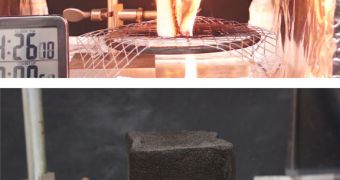A group of investigators at the US National Institute of Standards and Technology (NIST) announces the development of a new type of flame-inhibiting coating, which should be able to prevent house furnishings from catching fire.
These furnishings – including furniture cushions, children's car seats, and carpet paddings – constitute an important source of fuel for house fires, and are rather difficult to put out. In short, any surfaces covered with, or containing, polyurethane foam are very likely to burn up.
This is why constructors and engineers are using flame-retardants - specially designed chemicals that prevent the materials they cover from being burnt. However, some of these substances work better than others and some none at all.
The material the NIST team developed is based on clay. It comes in the shape of a thick, fast-forming coating, which contains an elevated concentration of small clay particles. These readily adhere to the spongy surface of polyurethane, preventing it from being burned even by an open flame.
“In effect, we can build the equivalent of a flame-retarding clay wall on the foam in a way that has no adverse impact on the foam manufacturing process,” NIST fire researcher Rick Davis says.
“Our clay-based coatings perform at least as well as commercial retardant approaches, and we think there's room for improvement. We hope this new approach provides industry with practical alternative flame retardants,” he goes on to say.
If the new discovery can be refined further, then the coating developed at NIST could provide the industry and homeowners with an efficient, green method of proofing their homes against the devastating effects of fire.
Since the material is based on clay particles, it is produced from natural, renewable sources, which makes it cheaper and less energy-intensive to manufacture than other chemicals on the market today.
Details of the new material appear in a paper entitled “Innovative approach to rapid growth of highly clay-filled coatings on porous polyurethane foam,” which is published in the latest issue of the esteemed journal ACS Macro Letters.
Foam covered with the new coating retains its original same softness, support and feel, since the clay-based material is only a few hundred nanometers thick.

 14 DAY TRIAL //
14 DAY TRIAL //